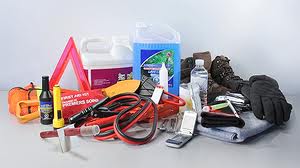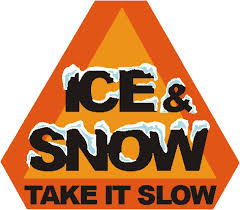
Winter driving can be hazardous and scary during the winter months. But being prepared can help make the trip safer and help you to deal with an emergency.
Plan Ahead
- Check your battery, tire tread, and windshield wipers. Make sure your tires are properly inflated and keep your windows clear, put no-freeze fluid in the washer reservoir, and check your antifreeze.
- Keep your gas tank at least half full to avoid gas line freeze-up.
- Have on hand flashlights, jumper cables, abrasive materials (sand, kitty litter, even floor mats), shovel, snow brush and ice scraper, warning devices (like flares), cellular phone, gloves, hats, blankets and if traveling long distances pack food, water, and medications. It is a good idea to make a Winter Driving Survival Kit, see recommended items below.
- Watch weather reports prior, especially if traveling long distances. Delay trips, especially if bad weather is expected. If you must leave, let others know your route, destination ad estimated time of arrival.
- Practice cold weather driving by rehearse maneuvers slowly on ice or snow in an empty lot, during daylight hours. Steer into a skid, know your brakes, and stopping distances are longer.
Winter Driving Survival Kit
It is a good idea to keep a winter survival kit in our vehicle. Having essential supplies can provide some comfort and safety for you and your loved ones. The following items are recommended:
- Ice scraper/snow brush
- Shovel
- Sand or other type of traction aid
- Tow rope or chain
- Jumper cables
- Road flares or warning lights
- Antifreeze
- Flashlight and batteries
- First aid kit
- Fire extinguisher
- Small tool kit
- Extra clothing and foot wear
- Non-perishable energy foods, like chocolate, instant coffee, granola bars, juice
- Bottled water
- Candles and a small tin can to hold the candle
- Water proof matches

Winter driving can be safe with planning and extra caution.
Protect Yourself and Your Vehicle
- Never warm up a vehicle in an enclosed area, such as a garage.
- Always clear any snow and ice from all windows, lights, mirrors and the roof before driving. Wait until your windows are clear of fog so you will have appropriate visibility.
- Everyone buckle up and use child safety seats properly. Never place a rear-facing infant seat in front of an air bag. Children 12 and under are much safer in the back seat.
- Avoid driving while you’re fatigued. Getting proper rest before taking on winter weather reduces driving risks.
- Drugs and alcohol never mix with driving.
- Keep your eyes open for pedestrians and other vehicles.
- Avoid using using parking brake in cold,rainy and snowy weather.
- Do not use cruise control when driving on any slippery surface.
- Always look and steer where you want to go.
- Slow down and increase distances between cars.
Driving Tips

- Accelerate and decelerate slowly. Applying the gas slowly to accelerate is the best method for regaining traction and avoiding skids. Don’t get in a hurry and take extra time to slow down for a stoplight. Remember, it takes longer to stop on slippery surfaces, so add additional time.
- Be more alert to the actions of other drivers. Anticipate cars coming from side streets and put extra distance between your vehicle and the one in front of you. If someone is too close behind you, don’t speed up; slow down or let them go around you.
- Slow down in snow and icy conditions, make turns slowly, and make all starts slow and smooth.
- Know your brakes. Keep a light touch on brakes. Even with anti-lock braking systems, you should apply light pressure to avoid locking brakes and causing a skid.
- Don’t stop if you can avoid it. If you can slow down enough to keep rolling until a traffic light changes, do it. Be aware of your surroundings and do not break any traffic laws.
- Don’t power up hills. Applying extra gas on snow-covered roads just starts your wheels spinning. Try to get a little inertia going before you reach the hill and let that inertia carry you up to the top. Try to avoid having to stop on a hill. As you reach the crest of the hill, reduce your speed and proceed down hill slowly.
- Remember that bridges and overpasses may freeze before the regular travel lanes of a roadway. Watch out for black ice, areas of the roadway that appear black and shine and where your vehicle can suddenly lose traction. Slow down in these areas and keep your foot off the brakes.
- If you get stuck or stranded, don’t panic. Stay with your vehicle for safety and warmth. Wait for help to arrive. If you have a cell phone, try calling for help. Try to always know your exact location.
- Keep your clothing dry. Wet clothing can lead to dangerous loss of body heat.
- Stay home. If you really don’t have to go out, don’t. Even if you can drive well in the snow, not everyone else can.
*Safe Driving Tips provided by AAA and the National Traffic Safety Institute.*
